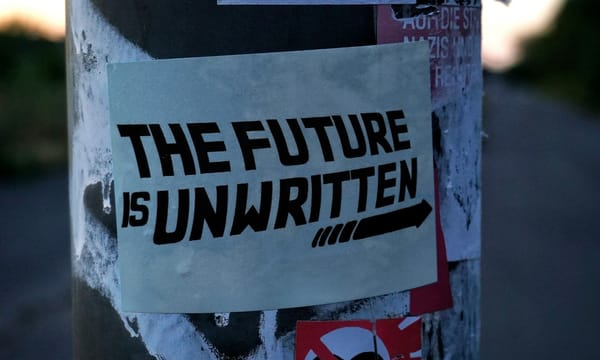Real-Life Resistance Doesn’t Look Like the Movies—So Let’s Change That
We’ve been raised on rebellion stories like Star Wars. Fiction tells us that when the regime tightens its grip, the resistance rises fully formed, deeply organized, and strategically flawless. But in real life? Most people don’t realize the story's already begun and we have to save ourselves.

The Lies Fiction Tells Us About Collapse
We’ve been raised on rebellion stories. Star Wars. The Hunger Games. V for Vendetta. The Handmaid's Tale. Equilibrium. The Maze Runner. Children of Men.
Fiction told us that when the regime tightens its grip, the resistance rises fully formed, deeply organized, and strategically flawless.
In these stories:
- District 13 already has a bunker full of prepared soldiers waiting for Katniss.
- The Rebel fleet is waiting for the signal to take out the Death Star.
- Factions are predetermined: the Institute, the Minute Men, the Brotherhood of Steel, the Railroad.
- Leaders know their mission—V spoke directly to the people and gave them a date to act.
- There’s a clear villain: Voldemort, The Capital, the Empire, Gilead regime, the Matrix itself.
- Righteous cause: Mayday resistance network. Escape the experiments and destroy WCKD.
- A path to victory: Reach the boat and get her to the Human Project—Theo doesn't have to start the resistance, he just has to deliver hope to it. Kill "Father," end the regime—Christian Bale's character defects from the enforcers, joins the resistance, and is told exactly how to fight and win.
But in real life? The authoritarian playbook unfolds slowly to a soundtrack of silence as the resistance is still arguing about definitions. Meanwhile, the machinery of repression locks into place.
Why Fiction Gives Us Emotional Catharsis And False Strategic Confidence
Stories are compressed by design. Characters are sorted into sides and factions form fast. Events accelerate toward resolution. We get the illusion of readiness—clarity, urgency, a shared mission.
This gives us emotional catharsis, but it sets us up for paralysis when the collapse begins without fanfare.
Real-world authoritarianism:
- Creeps in through policy, not proclamations.
- Doesn’t come with a narrator.
- Leaves people wondering if it’s really happening yet.
In fiction, you can feel the shift in tone. In reality, it’s disguised as “just politics.”
Narrative Readiness vs. Real-World Chaos
In fiction, you know who the rebels are. In real life, your neighbor is quoting Steve Bannon. Your friend is worried but waiting for a clearer sign. Your mayor says they support “free speech,” but they mean silencing protest.
We don’t get a rebel council. We get:
- Burned-out organizers.
- Surveillance and censorship.
- People too afraid or too numb to believe action is necessary.
Fiction skips over how hard it is to get people to care, especially when authoritarianism disguises itself in legal language and American exceptionalism.
Propaganda, Denial, and the Slow Death of Public Imagination
Authoritarian regimes rely on the myth of normalcy: “Everything’s fine. You’re overreacting. That can’t happen here.” But fiction trains us to expect collapse to feel dramatic. So when it doesn’t—when it feels like emails, budgets, press releases—we second-guess ourselves.
Propaganda does more than suppress truth. It suppresses imagination. It convinces us there is no alternative, no resistance, no future worth fighting for. And when collapse comes slowly, people expect someone else to already have the plan, the bunkers, the weapons.
But no one is coming. We are the rebellion.
And we are not ready.
What Real Resistance Looks Like (And Why It’s Not Cinematic)
Real-world resistance is messy. It looks like:
- A teenager printing zines in their bedroom.
- A local mutual aid group quietly feeding families.
- A trans woman teaching security culture in a church basement.
- A therapist creating collapse resilience workshops for burned-out activists.
It’s not always dramatic. It’s not always fast.
But it’s real. And it works when it has structure.
We Don’t Need a Soundtrack. We Need the Structure.
If you’re waiting for the moment the resistance begins—it already did.
If you’re waiting for the signal—this is it.
The Rebellion doesn’t exist yet, but we can build it. Not with symbols or slogans, but with strategy. Because when the next phase hits, it won’t look like a movie.
Start where you are. Organize. Learn. And most importantly, build parallel infrastructure.
Call to Action: Building Parallel Infrastructure
What is parallel infrastructure?
Parallel infrastructure refers to the creation of alternative systems that operate outside of or alongside existing institutions, especially when those institutions are failing, co-opted, or hostile.
It’s what people build when the government can’t, or won’t, protect them. It’s how resistance movements survive repression and serve communities at the same time.
Examples of Parallel Infrastructure in Action
1. Mutual Aid Networks
- Food, medical supplies, shelter, and community defense distributed without relying on the state.
- Think: Black Panthers’ Free Breakfast Program, pandemic-era food shares, tenant unions helping each other fight evictions.
2. Independent Communications Channels
- Encrypted signal groups, underground newsletters, pirate radio, mirror sites, burner phones.
- Purpose: bypass surveillance, censorship, and propaganda.
3. Guerrilla Clinics & Reproductive Health Access
- Abortion doulas and underground medical networks providing care in anti-choice states.
- Inspired by: Jane Collective, Zapatista community clinics, DIY health models.
4. Alternative Education Models
- Radical study groups, liberation schools, banned book libraries, “people’s history” workshops.
- Goal: deprogram state propaganda, pass on survival knowledge, teach truth.
5. Parallel Governance in Occupied Zones
- Indigenous land protectors, autonomous zones, or occupied protest spaces (e.g. Standing Rock, CHAZ) setting up rules, logistics, and defense systems.
- Real-time experiments in governing without the state.
Why It Matters
When authoritarian regimes capture the courts, law enforcement, and institutions, you can’t just vote your way out. You have to build around the regime.
Parallel infrastructure becomes:
- A shield for the vulnerable
- A launchpad for resistance
- A prototype for future self-governance
It’s not about purity or utopia. It’s about strategic survival.
Real-World Rebel Alliance = Parallel Infrastructure + Operational Readiness
If we want to build something like the Rebel Alliance for real, we need:
- Secure comms
- Resource logistics
- Defection havens
- Backup power, water, and info access
- Decentralized cells that can coordinate, not collapse, under pressure
So when I say “we need structure,” I mean:
Let’s stop imagining the bunker is already built and start designing the one we’ll need when collapse accelerates.
Want to help build the Rebel Alliance IRL?
Subscribe. Share. Take action.
This isn’t fiction anymore.
Sources
- Day, E. (2014, March 15). Zapatistas at 20: ‘They changed the world by showing that another world is possible’. The Guardian. https://www.theguardian.com/world/2014/mar/16/zapatista-20-years-mexico-rebel
- Jane Collective. (n.d.). History of the Jane abortion network. Chicago Women’s Liberation Union. https://www.cwluherstory.org/jane
- Rojava Information Center. (2020). Democratic Confederalism in Practice. https://rojavainformationcenter.com



